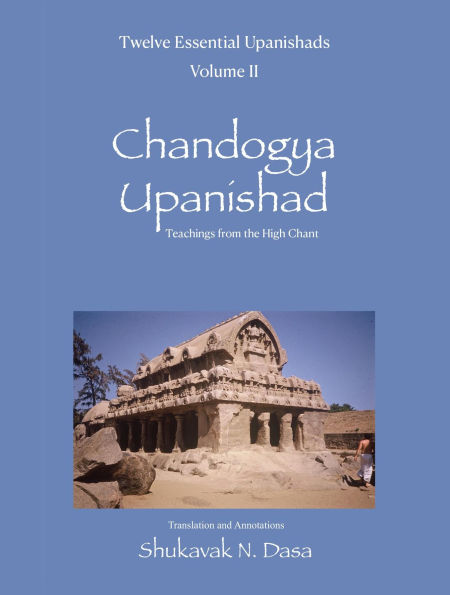Table of Contents
Introduction to the Upanishads
--First Adhyāya--Om as the High Chant. The Gods and Demons Quarrel. The High Chant from the Perspective of the Heavens. The Power of Om. Om as the Sun and Breath. The Union of the Rig and the Sama. The Debate on The Foundation of Sama. Space as the Source of the Sama. The Story of the Poor Priest. The High Chant of Dogs. The Mystical Meaning of Certain Sounds of the Sama Chant.
--Second Adhyāya--Sama as All Good. The Sama Chant in the World. The Sama Chant in Rain. The Sama Chant in Water. The Sama Chant in the Seasons. The Sama Chant in Animals. The Sama Chant in the Bodily Organs. Seeing the Seven parts of the Sama in Speech. Seeing the Seven Parts of the Sama in the Sun. The Syllables of the Sama Chant. The Gāyatra Sama Chant. The Rathantara Sama Chant. The Vāmandevya Sama Chant. The Bṛhad Sama Chant. The Vairūpa Sama Chant. The Virāja Sama Chant. The Śakvarī Sama Chant. The Revatī Sama Chant. The Yajñāyajñīya Sama Chant. The Sama Chant Built on the Whole. The Ways of Chanting. The Three Pillars of Dharma. The Rewards of Sacrifice.
--Third Adhyāya--Honey of the Rig. Honey of the Yajur. Honey of the Sama. The Vedas as the Essence. The First Nectar. The Second Nectar. The Third Nectar. The Fourth Nectar. The Fifth Nectar 56Where the Sun Never Rises or Sets57Gāyatrī 59Five Pathways of the Heart61The Knowledge of Shandilya. The Treasure Chest. The Doctrine of 116. The Life of Man is a Sacrifice. Brahma in Both the Individual and the Universe. The Sun as Brahma.
--Fourth Adhyāya--Raikva, The Man with the Cart. Janashruti Speaks with Raikva. Teachings to Satyakama Jabala. The Bull Teaches. Fire Teaches. The Swan Teaches. A Water Bird Teaches. The Teacher Teaches. The Story of Upakosala. Teachings from the Householder's Fire. The Southern Fire Instructs. The Eastern Fire Instructs. The Fires Conclude. The Path to Brahma. The Two Paths Created during Sacrifice. Correcting Mistakes during a Sacrifice.
--Fifth Adhyāya--Breath: the Oldest and the Greatest. The Power of Breath. Instruction to Gautama Begins. The Heavens are Fire Rain is a Fire. The Earth is a Fire. A Man is a Fire. A Woman is a Fire. The Course of Man. Ways of Leaving the World. Dialogue on the Universal Ātmā Begins. The Sky as the Universal Ātmā. The Sun as the Universal Ātmā. The Wind as the Universal Ātmā. Space as the Universal Ātmā. Water as the Universal Ātmā. The Earth as the Universal Ātmā. The Ātmā is beyond Measure. The First Offering. The Second Offering. The Third Offering. The Fourth Offering. The Fifth Offering. The Importance of Knowledge.
--Sixth Adhyāya--Teachings to Shvetaketu Begins. The Creation of the World. The Three Divinities and Name and Form. The Three Elements: Fire, Water and Earth. The Composition of a Body. A Person is Made of Sixteen Parts. The Nature of Sleep. Teachings to Shvetaketu Continued.
--Seventh Adhyāya--Instructions to Narada. Name. Speech. Mind. Will. Thought. Deep Reflection. Discernment. Power. Food. Water. Heat. Space. Memory. Hope. Breath. Outspoken for the Truth. Discernment. Thinking. Faith. Resolve. Action. Happiness. Abundance and Scarcity. Abundance is all Around.
--Eighth Adhyāya--The City of Brahma. The Object of Desire. Conclusion.
Sanskrit Glossary
Index



